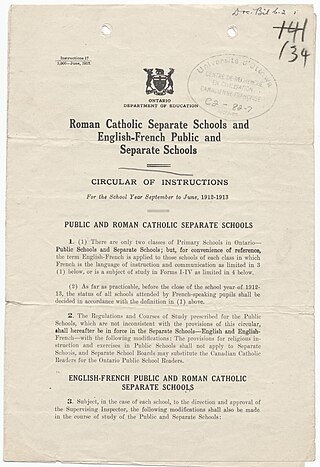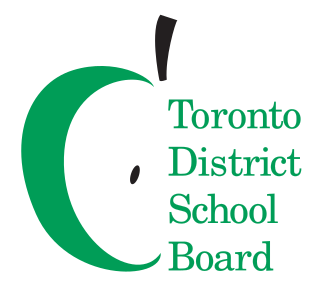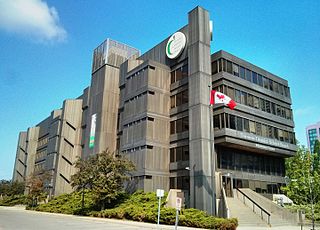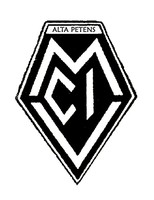History
Timeline

Upper Canada's Grammar School Act of 1807 provided the first public funds for schools in what would become Ontario. 8 schools were opened. [12]
- 1804: St. Johns Common School in St. Johns was one of Ontario's first schools.
- 1816: The Act of 1816 authorized local trustees to decide on hiring criteria for teachers. [13]
- 1823: A General Board of Education was established. [14]
- 1824: The Legislature supported "moral and religious instruction of the more indigent and remote settlements" by granting the Board of Education a budget to create Sunday schools. [15]
- 1824: The right to decide hiring criteria for teachers was transferred from trustees to the district Board. [15]
- 1834: The Mohawk Institute Residential School, the oldest continuously operated residential school in Canada, opens on Six Nations of the Grand River near Brantford [16]
- 1841: With the union of Upper and Lower Canada into the Province of Canada, the position of General Superintendent of Education was created. [15]
- 1843: With the realization that Canada West (formerly Upper Canada) and Canada East (formerly Lower Canada) had vastly different educational needs, the Act of 1841 was repealed. The Act of 1843 created the position of Chief Superintendent of Education for Canada West (which would become the Province of Ontario in 1867). [17] Egerton Ryerson is Chief Superintendent from 1844 until his retirement in 1876. [18]
- 1847: Chief Superintendent Egerton Ryerson returns from a tour of European education systems and submits his "Report on a System of Public Elementary Instruction in Upper Canada". [19] On the religious issue, he writes that "religious differences and divisions should rather be healed than inflamed". [19] : p62
- 1847: Chief Superintendent Ryerson nominated School Section no. 2 in Thorold Township and School Section no. 4 in Stamford Township as the first non-rate paying schools in Upper Canada under the advice of District School Superintendent Dexter D’Everado. [20]
- 1850: The Common School Act updates 1847 legislation creating school boards across Canada West. It requires; that municipalities meet the funding needs stated by their local school board and allows for schools to be paid for through provincial and municipal funds alone, allowing individual boards to eliminate school fees but not making this compulsory. The Act also allows for the creation of separate schools leading to provincially funded Catholic schools and to racially segregated schools. [21]
- 1870's: girls were admitted on equal terms with boys as education became compulsory for all children aged 7-12, but only for 4 months a year. [22]
- 1871: The School Act makes elementary education compulsory and free up to age 12. [21] The Act also created two streams of secondary education: high schools, the lower stream, and collegiate institutes, the higher stream. Extra funding was provided for collegiate institutes "with a daily average attendance of sixty boys studying Latin and Greek under a minimum of four masters". [23]
- 1876: The first Minister of Education was appointed, [15] after Ryerson retired after 22 years as Chief Superintendent of Education.
- 1891: The compulsory school-leaving age is raised to 14. [24]
- 1900's: education became compulsory to the age of 16; secondary school become free; the use of slates in the classroom ended. [25]
- 1921: The compulsory school-leaving age is raised to 16 in urban areas with exemptions for students needed at home or already in the workplace. [24]
- 1954: 16 becomes the compulsory school-leaving age for all students, with work exemptions. [24]
- 1968: Release of the Hall-Dennis Report, officially titled Living and Learning.
- 1970: Exemptions for work are removed from school legislation. All students must attend school until age 16. [24]
- 1984: Grade 13 is replaced by Ontario Academic Credit (OAC).
- 1997: Education funding moves to the provincial level. [26]
- 2003: Secondary education becomes a four-year program, with the phasing out of Ontario Academic Credit.
Racially segregated schools
An amendment to the 1850 Common School Act allowed for the creation of racially segregated schools. [27] This was because the Common School Act included the Separate School Clause that allowed for the separation between different religions and races. However, it was taken advantage of and quickly became problematic as school trustees supported racial segregation towards non-White students. [28] Racial segregation looked different depending on where it took place in Canada. Many of these schools were located in southwestern Ontario where Black individuals and families settled looking for freedom. [27] Some schools in Ontario had separate school buildings, while others attended the same school but at different times. [28] Those schools that were for Black students were characterized by markedly poorer conditions and little concern was shown for their education. [27] Scholars identify this as a suppressed history because it contradicts narratives of Ontario and Canada as places of justice and equality. [29] However, this history includes a legacy of slavery in Canada that lasted for over 200 years as well as acts of terror perpetuated by white Ontarians such as burning the barns of Black families to the ground. [30] The last racially segregated school in Ontario did not close until 1965. [31]
Residential schools in Ontario
Residential schools in Ontario were part of the larger Canadian Indian residential school system which spanned the country. The Mohawk Institute Residential School in Brantford, Ontario was the oldest continually-operating residential school in Canada. [32] Other residential schools also existed across the province. Egerton Ryerson was a key architect of the residential school system in Ontario. Residential schools were federally administered, meaning that the provincial government was not required to meet treaty obligations to Ontario First Nations for education. Reserve schools continue to be funded by the federal government today under a different funding model than provincially funded schools. [33] The curriculum in Ontario now includes the culture of Indigenous people, and the topic of maltreatment of Indigenous people in residential schools. [34]














